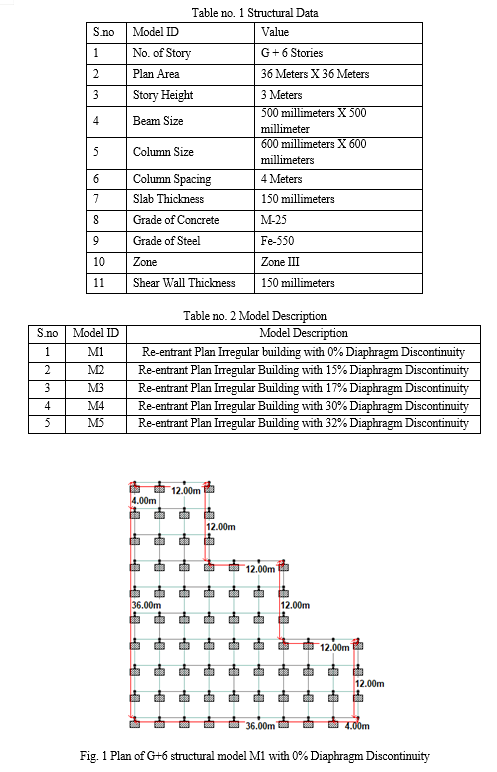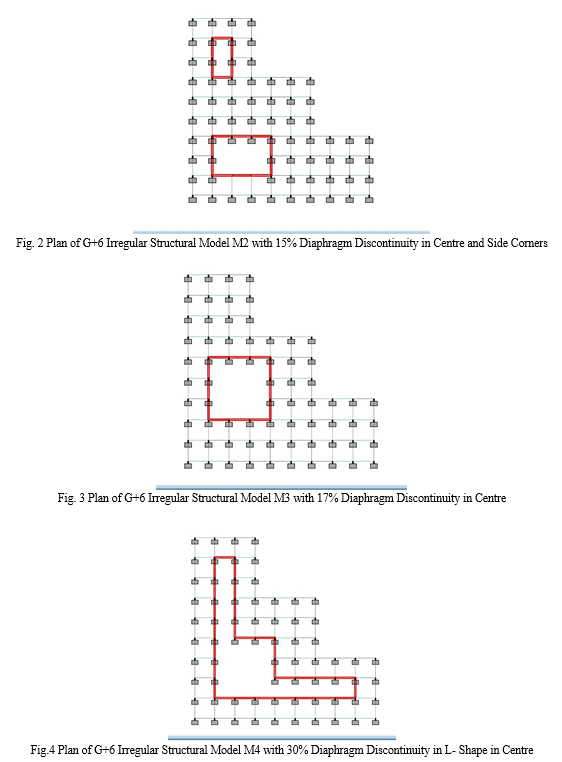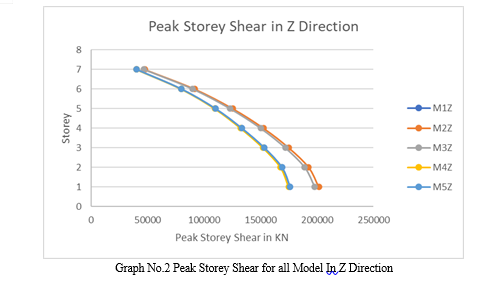Ijraset Journal For Research in Applied Science and Engineering Technology
- Home / Ijraset
- On This Page
- Abstract
- Introduction
- Conclusion
- References
- Copyright
Seismic Analysis of Re-Entrant Corner Plan Irregular Buildings with Roof Openings Using STAAD Pro: A Case Study for Zone III Earthquake Intensity
Authors: Sanjay Mayda, Surajmal Patidar
DOI Link: https://doi.org/10.22214/ijraset.2024.63643
Certificate: View Certificate
Abstract
This research investigates the possibility of including roof openings in the re-entrant corner plan irregular buildings at different positions for the response to seismic loads. Five different models with different types and levels of diaphragm discontinuity were analyzed using the STAAD Pro software. Variables such as node displacement, storey shear X and Z directions, stress, and maximum bending moment were investigated to measure the efficiency of the structure. The findings reveal that models featuring heightened diaphragm discontinuity tend to exhibit amplified node displacements, storey shear, and stress levels. Particularly, Model M3, showcasing a 17% diaphragm discontinuity, consistently demonstrates superior performance by showcasing reduced displacements and stress values compared to its counterparts. However, it\'s imperative to note that the ultimate selection of the model should be contingent upon specific project requisites and design considerations. In essence, the study underscores the importance of considering the impact of roof openings and diaphragm discontinuity on the structural behavior of re-entrant corner plan irregular buildings under seismic loads. While Model M3 emerges as a promising candidate for its favorable performance metrics, the holistic evaluation should encompass project-specific factors to ensure an optimal structural solution. This research underscores the significance of comprehensively evaluating structural performance in irregular buildings with roof openings. While Model M3 exhibits notable advantages, including reduced displacements and stress levels, the complexity of real-world projects necessitates a nuanced approach, considering factors beyond purely numerical analysis, such as architectural constraints and functional requirements.
Introduction
I. INTRODUCTION
Irregularities in building structures are common in urban areas. These irregularities often arise during the planning phase due to architectural and functional considerations. However, such irregularities have shown increased vulnerability in past earthquakes. Consequently, extensive research has been conducted in this field, primarily within the deterministic domain. This study aims to evaluate the relative performance of vertically irregular buildings within a probabilistic framework.
Vertical irregularities in buildings can result from a sudden decrease in stiffness or strength in a specific storey. In regions with high seismic activity, these irregularities pose significant challenges for structural engineers. Many urban infrastructures today feature numerous irregular structures, particularly open ground storeys and stepped buildings, which are prevalent in urban areas of India. Figure X illustrates a typical open ground storey and a stepped irregular framed building.
Plan irregularities in building structures refer to deviations from a regular or symmetrical floor plan. These irregularities can significantly impact a building's structural performance during seismic events. Plan irregularities can compromise the overall seismic performance of a building, making it more susceptible to damage or failure during an earthquake. Engineers and architects must address these irregularities by applying appropriate design and structural measures. Building codes and seismic standards often include provisions to mitigate the impact of plan irregularities and enhance the safety of structures in earthquake-prone regions..
II. OBJECTIVE
- Assess the Structural Behavior of Re-Entrant Plan Irregular Buildings with Varying Degrees of Diaphragm Discontinuity: Examine how different levels of diaphragm discontinuity impact the structural integrity and performance of re-entrant plan irregular buildings.
- Analyze Node Displacement Patterns within the Building Models: Study the displacement patterns at various nodes within the building models to understand how different configurations and levels of diaphragm discontinuity affect structural deformations.
- Compare the Node Displacement Results Among Different Models: Compare the displacement results of different models to identify trends and differences in structural response based on the percentage of diaphragm discontinuity.
- Contribute to the Development of Safer Building Designs: Identify potential vulnerabilities associated with re-entrant plan irregularities and diaphragm discontinuity to enhance the safety of building designs.
- Generate Data to Inform the Development or Refinement of Building Codes and Standards: Produce data that can be used to develop or refine building codes and standards related to re-entrant plan irregularities and structural discontinuity, promoting safer construction practices.
III. METHODOLOGY
The objective of this thesis is to investigate the effectiveness of openings in the roof of re-entrant corner plan irregular buildings at different locations when subjected to earthquake loads.
The earthquake loads are determined based on the guidelines provided in IS 1893 (Part-1). To analyze the structural response, the STAAD Pro software program is selected as the analysis tool.
In this study, the focus is on seismic analysis using the STAAD Pro program to investigate a specific validation problem. The aim is to analyze the behavior of a G+6-story unconventional residential building during an earthquake event. The building is characterized as multi-story, reinforced concrete-framed, and irregular in design. The analysis is performed using the response spectra method, considering the earthquake intensity of Zone III.
### Analysis Results
- Seismic Response of the Building: The seismic response of the G+6-story unconventional residential building was analyzed using the STAAD Pro software, focusing on the impact of roof openings at different locations.
- Displacement Patterns: The analysis revealed varying displacement patterns depending on the location of the roof openings. Roof openings positioned at re-entrant corners exhibited higher displacement compared to those centrally located.
- Stress Distribution: Stress distribution across the building structure was significantly influenced by the presence and location of the roof openings. Areas near the re-entrant corners experienced higher stress concentrations, increasing the potential for structural damage.
- Natural Frequency and Mode Shapes: The natural frequency of the building and its mode shapes were affected by the roof openings. Openings at re-entrant corners led to a decrease in natural frequency, making the building more susceptible to resonant frequencies during seismic events.
- Base Shear and Story Shear: The calculated base shear and story shear values indicated an increase in seismic forces for buildings with roof openings at re-entrant corners. This suggests a need for additional reinforcement in these areas to withstand seismic loads.
- Inter-Story Drift: Inter-story drift was higher in buildings with roof openings at re-entrant corners, potentially leading to greater damage to non-structural elements and increased risk of structural failure during an earthquake.
- Performance Comparison: Comparative analysis between different models showed that buildings with centrally located roof openings performed better in terms of structural integrity and seismic resistance compared to those with openings at re-entrant corners.
- Recommendations for Design: Based on the analysis results, it is recommended to avoid placing roof openings at re-entrant corners in earthquake-prone areas. If unavoidable, additional structural reinforcements should be considered to enhance seismic performance.
- Contribution to Building Codes: The findings of this study provide valuable data that can inform the development or refinement of building codes and standards, particularly regarding the placement of roof openings in re-entrant plan irregular buildings in seismic zones.
These results underscore the importance of careful consideration of roof opening locations in the design of re-entrant corner plan irregular buildings to ensure structural resilience during seismic events.




Conclusion
Considering the various factors and data provided, including node displacement, storey shear in both the X and Z directions, stress values, and maximum bending moment, we can draw an overall conclusion regarding the performance of the different models (M1, M2, M3, M4, and M5). A. Node Displacement 1) Models M2 and M4 generally exhibited higher node displacements across all storeys, suggesting decreased lateral stability as the percentage of diaphragm discontinuity increased. 2) Model M3 consistently showed lower node displacements, indicating better overall lateral stiffness and stability. B. Storey Shear 1) Model M2 consistently demonstrated the highest storey shear values, both in the X and Z directions, indicating that it experiences the highest lateral shear forces among the models. 2) Model M3 often followed M2 in terms of storey shear values, although the values were generally slightly lower. 3) Models M1, M4, and M5 exhibited lower storey shear values, with M1 frequently having the lowest shear values among them. C. Stress Values 1) Model M2 consistently experienced the highest stress levels, as indicated by Max Principal Stress, Max Von Mises Stress, and Max Tresca Stress. This suggests that it may be subjected to higher structural loads and potential material failure. 2) Models M1, M3, M4, and M5 generally had lower stress values, with Model M3 frequently displaying the lowest stress values. D. Overall Conclusion Considering the data available, it is evident that Model M2 consistently exhibits higher stress levels, larger node displacements, and higher storey shear values, indicating that it might be more susceptible to structural deformation and less stable under lateral loads. Model M3, (Re-entrant Plan irregular Building with 17% Diaphragm Discontinuity) on the other hand, consistently displays better overall performance in terms of lower node displacements and stress values. It\'s important to note that the selection of the best model may depend on specific project requirements, safety standards, and design considerations. Engineers would typically conduct a more comprehensive analysis, taking into account additional factors, such as cost, construction feasibility, and project objectives, to make a final decision on the most suitable model for a particular application.
References
[1] Raagavi and Sidhardhan “A Study on Seismic Performance of Various Irregular Structures.”, International Journal of Research in Engineering and Science (IJRES), Volume-9 (Issue-5), pp 12-19. (2021). [2] Khazaei et al. “Optimal Location of Multiple Tuned Mass Dampers in Regular and Irregular Tall Steel Buildings Plan. Shock and Vibration”, Volume 2020 (2020). [3] Prasad et al. “Seismic Response Analysis of Symmetrical and Asymmetrical High-Rise Structures in Seismic Zone II”, International Journal of Engineering Research and Applications, Volume-10 (Issue-10) (Series-III), pp 36-49. (2020). [4] Ilerisoy “Discussion of the Structural Irregularities in the Plan for Architectural Design within the Scope of Earthquake Codes”, Periodica Polytechnica Architecture, Volume-50 (Issue-1), pp 50–62. (2019). [5] Krishna and Sankar “Seismic Analysis of Multi Storied Buildings with Floating Columns”, International Journal of Innovative Research in Science, Engineering and Technology, Volume-8 (Issue-5), pp-6063. (2019). [6] Ahirwal, Gupta, and Singh “Effect of Irregular Plan on Seismic Vulnerability of Reinforced Concrete Buildings”, In Proceedings of the International Conference on Sustainable Materials and Structures for Civil Infrastructures (AIP Conf. Proc. 2158, AIP Publishing. (2019). [7] Sagl?yan and Yon “Assessment of Earthquake Behaviour of Reinforced Concrete Buildings with Slab Discontinuity”, Turkish Journal of Science & Technology, Volume-13 (Issue-1), pp 87-92. (2018). [8] Sanjay and Rao “Effect of Diaphragm Discontinuity in the Seismic Response of Multi-Storeyed Building”, International Journal of Research Sciences and Advanced Engineering (IJRSAE), Volume-2 (Issue-20), pp 182-187. (2018). [9] Sarojini and Kumar “Diaphragm Discontinuity Consequence with The Seismic Performance of RC Building”, International Journal of Innovative Technology and Research, Volume-6 (Issue-3), pp 8159-8161. (2018). [10] Sahu and Dwivedi “Seismic Analysis of RC Frame with Diaphragm Discontinuity”, IOSR Journal of Mechanical and Civil Engineering (IOSR-JMCE), Volume-14 (Issue-4) (2017). [11] Chacko and Eliyas “Seismic Analysis of Fixed Base and Base Isolated RC Buildings Having Diaphragm Discontinuity”, International Research Journal of Engineering and Technology (IRJET), Volume-04 (Issue-06), pp-1966. (2017). [12] Soni, Rawat, and Kushwah “Wind Analysis of Tall Building with Floor Diaphragm”, International Research Journal of Engineering and Technology (IRJET), Voulme-04 (Issue-03), pp-1095. (2017). [13] Bagawan and Patel “Seismic Performance Study of RC Framed Building with Diaphragm Discontinuity”, International Research Journal of Engineering and Technology (IRJET), Volume-04 (Issue-09), pp 103. (2017). [14] Kusuma “Seismic Analysis of a High-rise RC Framed Structure with Irregularities”, International Research Journal of Engineering and Technology (IRJET), Volume-04 (Issue-07), pp-1338. (2017). [15] Kadiyala and Kota “Effect of Diaphragm Discontinuity of the Building”, International Journal of Research in Engineering, IT and Social Sciences, Volume-06 (Issue-09), pp 33-40. (2016). [16] Habib et al. “Effect of Plan Irregularity on RC Buildings due to BNBC-2006 Earthquake Load”, International Journal of Scientific & Engineering Research, Volume-7 (Issue-1), pp-761. (2016). [17] Sawarkar and Nandurkar “Critical Analysis of Column Displacement and Forces in Selected Column for a Structure with Diaphragm at Different Levels”, International Journal of Science Technology & Engineering (IJSTE), Volume-2 (Issue-10), pp-806. (2016). [18] Abdlebasset et al. “Seismic Analysis of High-Rise Buildings with Transfer Slabs”, State-of-the-Art Review. Electronic Journal of Structural Engineering, Volume-16 (Issue-1). (2016). [19] Scarry “Floor Diaphragms and a Truss Method for Their Analysis. Bulletin of the New Zealand Society for Earthquake Engineering”, Volume-48, No. 1, March 2015. Structural Engineer, Auckland. (Submitted May 2014; Reviewed August 2014; Accepted December 2014). (2015). [20] Monish and Karuna “A Study on Seismic Performance of High-Rise Irregular RC Framed Buildings”, International Journal of Research in Engineering and Technology (IJRET), Volume-04 (Issue-05), pp 340. (2015). [21] Divyashree, M., et al. (2014). Comparison Of Bracings and Shear Walls as Seismic Strengthening Methods to Buildings with Plan Irregularities: International Journal of Research in Engineering and Technology, 3(6), 205-210. [22] Ahmed, J. A. K., & Sreevalli, Y. (2014). Influence of bracing location on the fundamental time period of high-rise buildings under seismic and wind loads. Journal of Earthquake Engineering, 18(4), 589-603. [23] Suresh, M. R., & Badami, S. (2014). Structural configuration suitability for buildings of different heights under gravity and wind loads. Journal of Constructional Steel Research, 94, 46-56. [24] Ozturk “A study of the effects of slab gaps in buildings on seismic response according to three different codes”, Scientific Research and Essays, Volume-6 (Issue-19), pp 3930-3941. (2011). [25] Gonzalez Herrera and Gomez Soberon “Influence of Plan Irregularity of Buildings”, In Proceedings of the 14th World Conference on Earthquake Engineering, October 12-17, 2008, Beijing, China. (2008).
Copyright
Copyright © 2024 Sanjay Mayda, Surajmal Patidar. This is an open access article distributed under the Creative Commons Attribution License, which permits unrestricted use, distribution, and reproduction in any medium, provided the original work is properly cited.

Download Paper
Paper Id : IJRASET63643
Publish Date : 2024-07-16
ISSN : 2321-9653
Publisher Name : IJRASET
DOI Link : Click Here
 Submit Paper Online
Submit Paper Online

